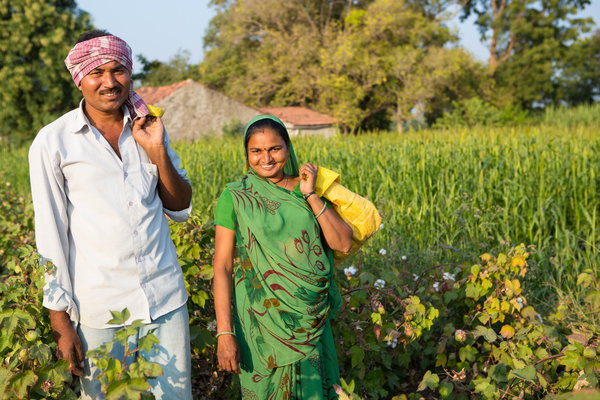Improving Farmer Livelihood, One Drip at a Time
At a time when it seems like the world is falling apart, success stories that illustrate how small efforts can make a big difference feel like balsam for the soul. I am lucky enough to be a part of a small team working to make an impact in the lives of cotton farmers in my home country of India.
Farmers in India, especially smallholder farmers, are facing unprecedented challenges. Issues like water scarcity and the growing risks associated with climate change, poor soil fertility and loss of biodiversity, and farmer poverty are threatening the very fabric of rural Indian life.
Recognising this threat, and in particular that of water scarcity, the Government of Gujarat created a Special Purpose Vehicle (SPV) called “Gujarat Green Revolution Corporation” (GGRC) to provide subsidies to farmers to install drip irrigation. This modern agricultural technique that irrigates crops with tiny droplets of water, helps farmers save time, money, and water. The GGRC subsidy, which can vary from time to time, currently covers about 70% of the cost of installation, with the remaining 30% left to be borne by farmers themselves.

Sounds straightforward. The problem is that smallholder farmers usually do not have the resources to pay the remaining amount for drip and they cannot obtain formal credits because they often lack documentation and collateral. Without formal credit institutions to service them, farmers are left with no choice but to borrow money at exorbitantly high rates from informal moneylenders. So, despite the GGRC subsidy, drip irrigation remains a luxury that only medium and large-scale farmers can afford.
To bridge this gap, C&A Foundation in partnership with Aga Khan Foundation and Aga Khan Rural Support Programme India, established a community funding mechanism to provide interest free loans to smallholder cotton farmers in the Saurashtra region of Gujarat. With their loans, farmers have been able to pay the remaining amount, avail the GGRC subsidy, and install drip irrigation on their cotton farms. As farmers repay their loan, within a period of two years, the amount goes back into a “community managed fund”, which is managed by the community farmers groups and is used to give further loans to other farmers.
At C&A Foundation, we have been working with this Drip Pool Programme for several years, during which time I have personally been able to witness the value of this scheme not only for the farmers but also for the environment. Now, thanks to the data gathered in our new report “Bridging the credit gap: Water sustainability through innovative financing , we are finally able to prove it.
First and foremost, the report shows that in 2017-18, farmers in the programme have been able to achieve a net income 31% higher from their cotton cultivation compared with farmers that are not using drip irrigation. That is about Rs 22,575 (EUR 301) per acre, compared to Rs 17,325 (EUR 231) per acre reported by farmers without drip irrigation. And thanks to this increase in income, the quality of life has increased for their entire households. A farmer called Vallabh explained this as such:
“When there was no drip we had to pump water from the well. We had to get up at night to create a canal for the water and then stand while that canal filled up. It needed many of us and labour was expensive. Now, the men we required for irrigation can be used in other places and we can grow vegetables and peanuts.
When we didn't use drip, we used to spend around Rs 70,000-80,000 (EUR 930-1,060) a year on irrigation, making just Rs 10,000-15,000 (EUR 130-200) profit a month. After drip, we have been able to increase our profit to Rs 25,000-30,000 (EUR 330-400) a month.
That money is now invested in my children's education. Before we couldn’t do that. And our houses have changed. Earlier we used to stay in huts, now we have a new concrete house. Because of the costs that have reduced due to drip, the lifestyle that we could not afford earlier, even food and shelter, we have been able to do that.”
But the programme has yielded far more benefits that “just” an increase in income, with farmers seeing environmental impacts as well. Programme farmers have reported using just 1,191 litres of water per kilogram of cotton, compared to the 5,923 litres consumed by non-drip farmers; or in other terms, an acre of cotton cultivation under the programme uses around 2.5 million litres less water compared to peers. And drip irrigation also helps to conserve soil fertility by avoiding top soil erosion and making the fertilisation process more efficient.
One of my favourite impacts has been the effect on the farming communities. At the community level, Farmer Interest Groups (FIGs) have been formed to keep track of the loans taken by farmers. These groups have become a vital, vibrant part of community life and they are used to discuss issues related to agriculture. The FIGs then are federated to form Farmer Producer Organizations (FPOs), that are not only responsible for overall management of the fund but also help the farmers to purchase their inputs and access markets as a collective. This kind of ownership on the community level will help this programme live on long after C&A Foundation and its partners have left.
To keep up with mounting agricultural challenges facing India, we need to start thinking out of the box. C&A Foundation’s Drip Pool Programme shows that multi-stakeholder partnerships with strong community ownership can help create environmentally and financially sustainable agricultural systems that promote not only the health of ecosystems, but also of the people who depend on them.

